|
View previous topic :: View next topic
|
|
| Author |
Message |
RoundTheBend
I miss the comfort in being sad

Location: Ground Control

|
- #191
- Posted: 01/04/2019 05:56
- Post subject:
|
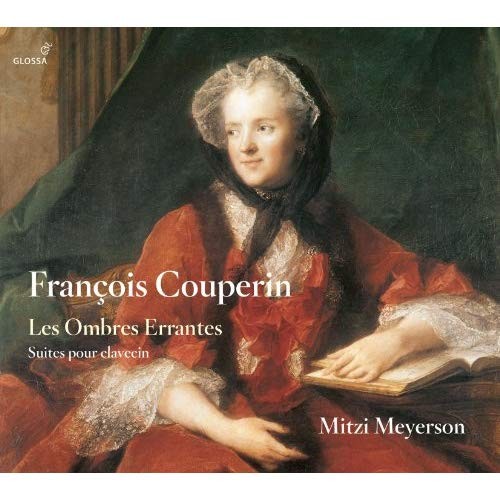
Couperin: Les Ombres Errantes by Mitzi Meyerson
Era: Baroque
Year: 1730 (published as
Form: Harpsichord Suites
Score: 82
Thoughts: I think what I liked most about these compositions is they felt simultaneously mathematical (and I mean that in a good way, like geometric/symmetry - music is all about space and time after all and this beautifully masters space and time), but also emotional in playing with those elements. This type of music isn't my cup of tea, but it seems more playful than perhaps others I've hereto listened to, including Scarlatti and even Bach's harpsichord works, perhaps better balancing the emotion with the equation.
Lindsay Kemp: Gramophone
| Quote: | Given that she has always tended to treat every gavotte and minuet that comes her way as crisp little character pieces, Mitzi Meyerson would seem an ideal interpreter for François Couperin. In these four Ordres (or suites) from his last book of pieces, published in 1730, the territory ranges from the grandeur of ‘La trophée’ to the tenderness of ‘Le point du jour’, and from the rusticisms of ‘La croûilli’ to the theatrical good humour of ‘La pantomime’.
Meyerson does indeed find her own way in each of the 25 pieces, delivering interpretations that are decisive, strong-minded and unafraid to play for effect. Phrasing and rhetoric are emphasised with fearless though smoothly controlled variations in tempo, and registration and spiky articulation are likewise put to good expressive use; a typical touch is to toy with the ending, as in the throwaway final note of the 26th Ordre’s Gavotte, or the coy trip up the octave in ‘Les tambourins’.
Such things are to be expected from one of the most distinctive harpsichordists around, though the downside is, of course, that it will not appeal to everyone. Her quirkiness can be endearing but with her strong fingers and tendency not to employ spread chords and other rhythmic dislocations as much as some of her colleagues, her playing can acquire a ‘big’ and percussive quality; some may find themselves wishing for a touch more lyrical poetry. This is not definitive Couperin then – how could anyone’s be? – but its expertise and lively imagination certainly repay hearing. |
| Quote: | François Couperin was one of France's most prominent composers in the decades around 1700. Although in many ways he was part of a long tradition of French music, his output shows the increasing influence of Italian music. His keyboard works are considered characteristic of Couperin's musical preference for quiet music and inner expression. But, although he never wrote a composition for the theatre, the programmatic and character pieces in his harpsichord suites are not very different from the way human characters and emotions are portrayed in contemporary theatrical works. From time to time Couperin also gives instructions to the performer as to how to play specific pieces in order to express what he intended. 'Les Tambourins' from the Ordre No. 20, for instance, should be played with "even notes", meaning that 'notes inégales' are out of place here, obviously in order to underline the exotic, non-French origin of this piece.
Couperin wrote 27 harpsichord suites, published as 'Ordres' in four books from 1713 to 1730. This disc brings together four suites from the fourth and last book, which appeared in 1730 after which due to poor health he stopped composing. In the preface he explains the pieces in this book had been finished about three years before. This volume contains more Ordres than the previous four books (8 ), but fewer pieces. The shortest Ordre is No. 27 (not recorded here) which consists of just four movements, whereas the 2e Ordre from the first book has 23 movements. Other remarkable features in the fourth book are the fact that most pieces are in two parts, and that the upper register of the keyboard is dominant, which gives these Ordres a somewhat lighter touch than the suites in the previous books. Also remarkable is the use of the rare key of F sharp minor (26e Ordre).
The Ordres in this fourth book appear to contain few dances or so it seems. In fact many of the pieces are dances in disguise. For instance, 'La Convalescente' (26e Ordre, No 1) is an allemande, 'La Boufonne' (20e Ordre, No 2) a gigue. In that respect Couperin sticks to tradition. But he breaks with tradition in that no suite begins with a prelude and in this his Ordres differ from almost any suite by his predecessors.
The 22e Ordre which opens this disc is in the key of D major andaccording to Marc-Antoine Charpentier is "joyful and warlike", and that is an appropriate description of the character of this suite. This is especially true of its first movement, 'Le Trophée' (the trophy) in particular, one of the most theatrical in the fourth book. In 'L'Anguille' Couperin brilliantly depicts the writhings of the eel. The last two movements are connected, but also contrasting: in both movements the hands cross each other, but in 'Menuets croisés' they play on different manuals, whereas in 'Les Tours de Passe-passe' both hands play on the same manual.
The 26e Ordre is in f sharp minor - the only suite in this key in all four books. The opening movement, 'La Convalescente', is a description of the process of recovering from illness. The first section contains a chromatic descending bass, probably referring to the illness. Evocative is 'L'Épineuse' (the thorny one) in which the music depicts thorns, effectively using the upper register of the keyboard.
The 20e Ordre starts with 'La Princesse Marie', a homage to Maria Leszczynska, the future Queen of France (wife of Louis XV). As she was of Polish origin this piece, which is in three sections, ends with an 'air au gôut polonois', which is a mazurka. Like the 'tambourins' mentioned before Couperin directs that this piece be played "evenly and well-marked", underlining its foreign character. This suite contains two movements which form a kind of duet between two contrasting characters, 'La Fine Madelon' and 'La Douce Janneton'. The contrast between the two ladies is expressed by the use of dissonances.
The 25e Ordre starts with 'La Visionaire', another theatrical piece which is written in the form of an opera overture. This suite contains dramatic contrasts, as this piece and also the fanfare-like 'La Muse Victorieuse' are very different from more poetic pieces like 'La Monflambert' and 'Les Ombres Errantes', which closes the suite and the disc.
Mitzi Meyerson gives splendid performances. She is well aware of the character of every single piece and expresses their character eloquently. The use of 'notes inégales' is very subtle, as it should be, and accelerandos and rallentandos, which - according to Pierre Mamou in the programme notes - are features of the French taste, are used as means of expression. I wonder, though, why Ms Meyerson uses them in 'Les Tambourins' from Ordre 20, which Couperin specifically requires to be played "with even notes".
This is an exemplary production: some of the finest music Couperin has ever written, excellent performance and recording, a beautiful instrument - a harpsichord by Keith Hill, a copy of a Taskin from 1769 - and a booklet with informative programme notes. Every reason to recommend this disc.
-- Johan van Veen, MusicWeb International |
Last edited by RoundTheBend on 01/20/2019 04:26; edited 1 time in total
|
|
|
|
|
Back to top
|
|
|
|
RoundTheBend
I miss the comfort in being sad

Location: Ground Control

|
- #192
- Posted: 01/12/2019 19:30
- Post subject:
|
I stumbled on this site before on my baroque travels but only for specific information or hard to find recordings. Turns out to be a great resource for anyone interested in a wide but possibly shallow dive into Baroque music:
http://www.baroquemusic.org/
|
|
|
|
|
Back to top
|
|
RoundTheBend
I miss the comfort in being sad

Location: Ground Control

|
- #193
- Posted: 01/20/2019 04:21
- Post subject:
|

Era: Baroque
Year: 1733
Form: Table Music (music to be played at banquets/feasts)
Score: 82
Thoughts: I've listened to a couple different recordings on this and then also found there's the 4 hour version and then the zusammenfassung. I really want to get into Telemann, but I really am struggling to find anything great. I was hoping this would get me there as it's one of his more well known works. Handel stole directly from it (as a form of respect in those days) and it is indeed nicely arranged, etc., but that's just it... it's music for a feast. Like, when was the last time you fell in love with background music? Idk... I tried, but really am not finding anything terribly intriguing about Telemann's music. He as a person appears to have been incredibly important in his time, but his music by itself just doesn't do anything for me - other than be nice background music as I write this. I'm glad I listened to it and it is indeed pleasant, but lacks any depth to want me to come back for more.
Of course this guy has nicer things to say:
| Quote: | James Manheim -AllMusic.com
Georg Philipp Telemann's Tafelmusik is a collection of orchestral and chamber music in three large parts, each consisting of half a dozen works. It contains plenty of colorful music that's often heard by the piece, and the entire set, covering four CDs, represents a serious investment of time and money, even at the discounted price of this Harmonia Mundi release. Yet there's a strong case that a good Baroque music collection and certainly a library should contain a copy of the whole set, as indeed many collections did in the middle of the 18th century. The work's title and concept are modest: Tafelmusik means "table music," and each work in the individual sets is meant to correspond with a course of a meal. But the utilitarian veneer conceals an ambitious and synoptic work. The booklet notes (in French, English, and German) goes into quite a bit of detail: not only did Telemann participate in the ongoing effort to reconcile and combine the French and Italian styles, he also deepened his stylistic survey in several other ways. Most strikingly, he wrote French works with Italian elements, and vice versa. The Overture in D major that opens Part II (CD 2, tracks 10-14) is ostensibly a French form, but its individual movements avoid dance movements and instead exploit the group contrasts of Italian music. Further, the combination of orchestral and chamber music, which Telemann explicitly specified (and which ought to give pause to groups that automatically assume small ensembles are best), is unusual in itself. On top of all this, the occasional dashes of Polish folk rhythms (try the finale of the Quartet in D minor, CD 2, track 18 ) and the appearance of the new genres of sinfonia and quartet all combine to give the collection, taken as a whole, a brilliantly kaleidoscopic quality. The Freiburg Baroque Orchestra simply does not have a weak point in addressing the set's many demands. Vivacious soloists, crisp orchestral ensemble work, a certain feel for Telemann's pure flair: it's all here, and with absolutely top-notch sound, it adds up to a must-have for serious Baroque enthusiasts. |
|
|
|
|
|
Back to top
|
|
RoundTheBend
I miss the comfort in being sad

Location: Ground Control

|
- #194
- Posted: 01/23/2019 03:16
- Post subject:
|

Pergolesi: Concerto Di Violino Con Più...archigiana
Era: Baroque
Year: 1730
Form: Chamber Works
Score: 82
Thoughts: The performances here, particularly the organ, violin, and cello, stood out to me as better than most. Still ok music. Nothing great, nothing terrible. The typical mathematical runs you get from Baroque, but not terribly convincing of any real purpose.
From prestomusic:
| Quote: | | More than 60 instrumental compositions scattered in various musical libraries are attributed to Giovan Battista Pergolesi, but we know today that only a small part of them can be considered authentic without a doubt. The others, except for a few for whom the real composer has been found (Count Wilhelm Unico van?Wassenaer for the famous “Concerti armonici”, Graun, Alberti and Gallo) are all anonymous. These recordings, based on Marvin E. Paymer’s authoritative catalogue of Pergolesi’s works, include all of Pergolesi’s instrumental compositions, both those known to be authentic and works which are “probably” his. |
|
|
|
|
|
Back to top
|
|
RoundTheBend
I miss the comfort in being sad

Location: Ground Control

|
- #195
- Posted: 01/26/2019 22:26
- Post subject:
|
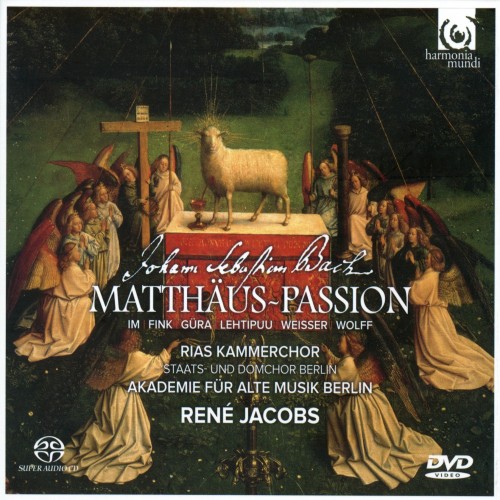
J.S. Bach: Matthäus-Passion by René J...sik Berlin
Era: Baroque
Year: 1727
Form: Oratorio
Score: 84
Thoughts: Matthew chapter 26 and 27 - which appears to be Jesus' time before he was crucified with the apostles. Lots of recitative that didn't really capture or move me. The recurring theme in the passion chorales was probably the highlight for me. Dense arrangements at times in other works that were nearly great, but the recurring passion chorale is easily the most famous part of the oratorio.
From AllMusic (Blair Sanderson):
| Quote: | | Among the finest early music conductors, René Jacobs has recorded many of the great choral works and operas of the Baroque and Classical eras, almost exclusively for Harmonia Mundi. Yet he has waited decades to record J.S. Bach's towering masterpiece, the St. Matthew Passion, despite having studied and performed it many times throughout his career, first as a boy soprano, then years later as a countertenor and conductor. Fortunately, this 2013 release is well worth the wait, and Jacobs has produced a magnificent multichannel version that is a treasure for audiophiles and connoisseurs of this hallowed work. The large box set houses two SACDs and a DVD, along with a thick booklet, so the St. Matthew Passion is given a thorough presentation, and the recording offers clear instrumental details, rich choral textures, and full presence for the soloists. The RIAS Kammerchor and the Akademie für Alte Musik Berlin deliver majestic performances of the choruses in authentic period style, and tenor Werner Güra as the Evangelist and bass Johannes Weisser as Jesus are well-matched in their fluid vocal quality and intense dramatic feeling. But the whole feels much greater than the sum of its parts, and the experience of hearing this extraordinary performance is overwhelming, both intellectually and emotionally. This set is highly recommended as one of the best recordings of 2013. |
|
|
|
|
|
Back to top
|
|
|
|
RoundTheBend
I miss the comfort in being sad

Location: Ground Control

|
- #196
- Posted: 01/27/2019 03:58
- Post subject:
|
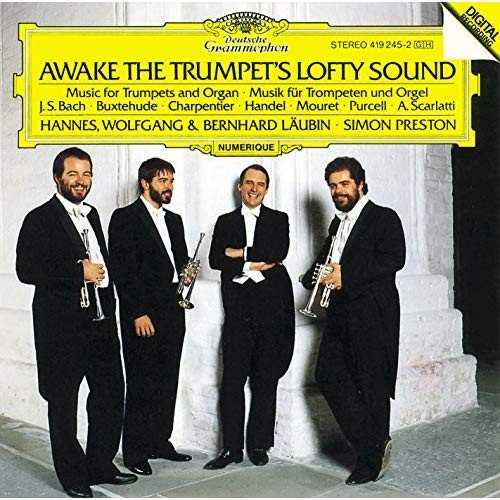
Awake The Trumpet's Lofty Sound: Music ...on Preston
Era: Baroque
Year: 1729 for Mouret's Rondeau
Form: Oratorio
Score: 83
Thoughts: Very nice change of pace, even if mostly brass soloists. I mostly chose this album because it was Deutsche Grammophon and because of Mouret's famous Rondeau piece. Probably the next most welcoming track was "See, the conqu'ring hero comes!" by Handel. It's a "nice" record, but also nothing incredibly inspiring. I'd totally put it on again if I wanted some "uplifting" and energetic music - marches and brass and all.
From arkivmusic.com:
| Quote: |
The Läubin brothers give superb performances in this most enjoyable celebration of noble sounds and music.
Music in which trumpets and organ work together on equal terms was rare before this century, so most of the items on this recording are arrangements in which either or both parties wear 'other men's hats'. Thus, for instance, in the Handel Sonata we have trumpets for violins and in the cantata and oratorio movements the organ does duty for the orchestra. A great deal of the music is of the triumphant, celebrational kind, with fanfares and variants of the 'horn idiom' well to the fore, that being the natural province of the early trumpet; the spectacular exception, that of the high-register clarino is absent.
Relief from the continual sound of brass, should you welcome it, comes in the form of organ-solo items by Purcell and Buxtehude, appropriate in that Purcell was organist at Westminster Abbey, as Preston is, and Buxtehude was similarly employed at the Marienkirche in Lübeck, in the Cathedral of which town this recording was made. I am reminded of Segovia's statement, that though the solo guitar can 'imitate' many instruments the illusion is destroyed in their presence; so it is when the organ 'confronts' the brassy warmth of real trumpets.
The Läubin brothers, who normally work with separate orchestras, form a fine ensemble, and the organ has magnificent clarity and quality of sound. The recording has a generous acoustic, with final sounds dying away after the magical fashion of such buildings, despite which there is no muddiness in the CD format in which it has come to me. It seems superfluous to say that the performances are superb in this most enjoyable celebration of noble sounds and music.
-- Gramophone [3/1987] |
|
|
|
|
|
Back to top
|
|
RoundTheBend
I miss the comfort in being sad

Location: Ground Control

|
- #197
- Posted: 01/29/2019 02:38
- Post subject:
|
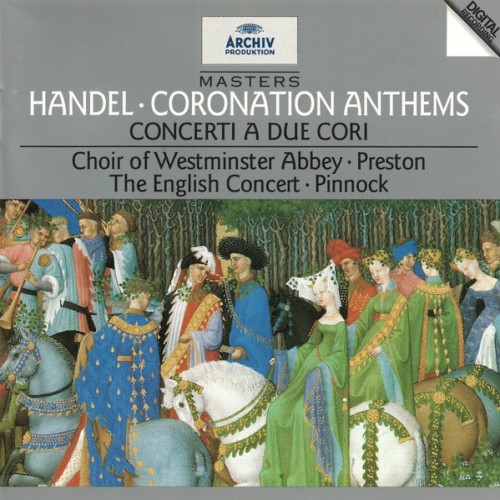
Handel: Coronation Anthems; Concerti A ...ster Abbey
Era: Baroque
Year: 1727
Form: coronation anthem and concerto
Score: 84
Thoughts: God Save the King! ... or not. IDK - I really like the music, but find many of the elements stolen from the Messiah, but slightly more celebratory obviously... for the coronation. The Concerti A Due Cori was a nice combination with the coronation anthems. It was a nice, lush listen as you'd expect from Handel, but I also have reservations with it.
Alternate option/recording with some additional info, who also pairs the coronation with the concerto: https://www.baroquemusic.org/44Web.html
|
|
|
|
|
Back to top
|
|
RoundTheBend
I miss the comfort in being sad

Location: Ground Control

|
- #198
- Posted: 01/29/2019 03:05
- Post subject:
|
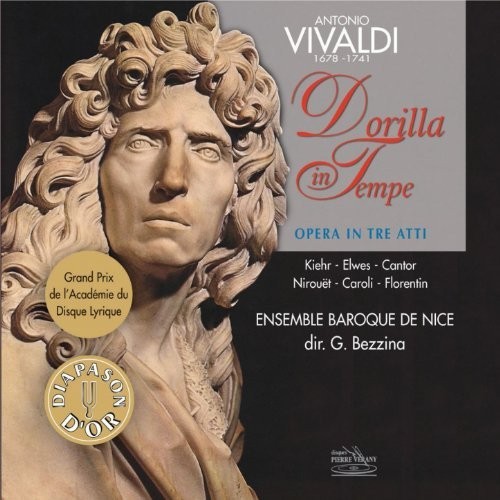
Vivaldi: La Dorilla In Tempe, Opéra En...ue De Nice
Era: Baroque
Year: 1726
Form: Opera
Score: 85
Thoughts: While I later find out only part of this really is what's left of what Vivaldi wrote, I find the passion in the style of Vivaldi (but that again is hard to decipher from modern interpretations). This is easily musically the least boring opera I've ever heard. Opera often is telling a story and unless I'm watching it or have memorized what's happening, I bore incredibly quickly during a spout of recitatives on the music front. This however used amazing dynamic and musically was a passion powerhouse. I very much enjoyed it. It has a scene in it about Spring and having written the four seasons the year before, in true baroque style steals his own music and puts it as the chorus of the first act.
David Vickers, Gramophone:
| Quote: | The heroic-pastoral melodrama Dorilla in Tempe (Venice, 1726) was revived by Vivaldi in 1728 (Venice) and 1732 (Prague), but the only version for which a musical source survives is a pasticcio rearrangement put on at Venice’s Teatro Sant’Angelo in 1734 – so about half the arias are not by Vivaldi. Diego Fasolis and I Barocchisti deliver a ripe and zesty performance that is immeasurably superior on all fronts to the patchy recording by the Ensemble Baroque de Nice directed by Gilbert Bezzina (Pierre Verany, 2/95). In this new account there is dramatic tautness to recitatives that recount the tribulations that hinder the blissful union of Dorilla (a princess of Thessaly) and Elmiro (a shepherd), whose rival Nomio turns out to be the disguised Apollo; the god slays the dragon Python that is plaguing Thebes, but eventually resigns his claim on Dorilla, sorts out the misunderstandings between the bickering lovers Eudamia and Filindo, and presides over a double marriage ceremony.
The opening chorus ‘Dell’aura al sussurrar’ heralding the arrival of spring is a parody of the beginning of The Four Seasons (published shortly before the original 1726 production); it is played and sung charismatically, although I am surprised that the additional interleaving solo passages are taken by entire sections of the Coro della Radiotelevisione Svizzera. Several brief hunting choruses are dispatched with verve at the end of Act 2, although gutsy velocity is at the expense of bucolic charm. King Admeto’s astonished response to Nomio’s promise to slay Python (‘Dall’orrido soggiorno’) is sung boldly by Christian Senn and horns introduced halfway through pack a surprising punch. Dorilla’s horrified reaction to being sacrificed to appease Python (in a manner like Andromeda chained to the seashore) is acted powerfully by Romina Basso, although Fasolis’s interventionist continuo instrumentation with bubbling organ and other tricks is unnecessarily distracting.
Elmiro’s energetic Neapolitan-style arias by Hasse and Leo are sung vivaciously by Serena Malfi. Filindo’s explosive aria di bravura ‘Rete, lacci, e strali adopra’ (by Giacomelli) showcases Lucia Cirillo’s declamatory brilliance, whereas Marina de Liso’s stylish singing is complemented by softly tender strings and intimate plucked continuo realisations in Nomio’s ‘Bel piacer saria d’un core’ (also by Giacomelli). Sonia Prina is in extrovert voice as Eudamia; the densely whirling strings in ‘Al mio amore il tuo risponda’ is unmistakably authentic Vivaldi, as are the thrilling shifts of unbridled tension in Nomio’s ‘Fidi amanti al vostro amore’.
It is possible to imagine a less abrasive and more charmingly shaded account of this rarely revived curiosity but the long-awaited resumption of Naïve’s Vivaldi Edition is cause for celebration. |
|
|
|
|
|
Back to top
|
|
RoundTheBend
I miss the comfort in being sad

Location: Ground Control

|
- #199
- Posted: 01/30/2019 01:47
- Post subject:
|
So just pulled out this record and on the back for Bach's "Jesu, Joy of Man's Desiring" it has a note that says: Bach had twenty children because his organ didn't have any stops... hehe

6- And 12-String Guitar by Leo Kottke
|
|
|
|
|
Back to top
|
|
RoundTheBend
I miss the comfort in being sad

Location: Ground Control

|
- #200
- Posted: 01/30/2019 03:59
- Post subject:
|

Vivaldi: The Four Seasons by Gil Shaham... Orchestra
Era: Baroque
Year: 1725
Form: Concerto (arguably program music)
Score: 100
Thoughts: Easily a 100 for me. It's easily some of the most passionate, meaningful, ingenious, and inspiring music ever made. My first day when I moved to Munich I heard this on the streets and it warmed my heart. I am filled with so much life whenever I listen to this music. My demon inspires (a la Goethe). Lately I've been trying to find the best recording of this I can buy on vinyl which captures appropriately the vibrancy of spirit, yet is true to music. Here's a few lists:
1. Carmignola, Marcon (cond.), Venice Baroque Orchestra (1999)
2. Biondi (violin & cond.), Europa Galante (1991)
3. Standage, Pinnock (cond.), The English Concert (1982)
4. Shaham, Orpheus Chamber Orchestra (1993)
5. Loveday, Marriner (cond.), Academy of St. Martin in the Fields (1969)
6. Onofri, Antonini (cond.), Il Giardino Armonico (1993)
7. Sparf, Drottningholm Baroque Ensemble (1984)
8. Biondi (violin & cond.), Europa Galante (2003)
9. Ayo, I Musici (1959)
10. Lamon (violin & cond.), Tafelmusik (1991)
1. Guiliano Carmignola, Sonatori de la Gioiosa Marca, Divox Antiqua label
2. Simon Standage, The English Concert, Trevor Pinnock, Archiv label
3. Fabio Biondi, L'Europa Galante, Opus 111
4. Christopher Hogwood, The Academy of Ancient Music, L'Oiseau lyre
5. Guiliano Carmignola, Venice Baroque Orchestra, Sony label
6. Adrian Chandler, La Serenissima
7. Nils-Erik Sparf, Drottingholm Baroque Orchestra, BIS label
8. Enrico Casazza, La Magnifico Comunità[/quote]
Spring
Allegro
Springtime is upon us.
The birds celebrate her return with festive song,
and murmuring streams are
softly caressed by the breezes.
Thunderstorms, those heralds of Spring, roar,
casting their dark mantle over heaven,
Then they die away to silence,
and the birds take up their charming songs once more.
Largo
On the flower-strewn meadow, with leafy branches
rustling overhead, the goat-herd sleeps,
his faithful dog beside him.
Allegro
Led by the festive sound of rustic bagpipes,
nymphs and shepherds lightly dance
beneath the brilliant canopy of spring.
Summer
Allegro non molto
Under a hard Season, fired up by the Sun
Languishes man, languishes the flock and burns the pine
We hear the cuckoo's voice;
then sweet songs of the turtledove and finch are heard.
Soft breezes stir the air, but threatening
the North Wind sweeps them suddenly aside.
The shepherd trembles,
fearing violent storms and his fate.
Adagio e piano - Presto e forte
The fear of lightning and fierce thunder
Robs his tired limbs of rest
As gnats and flies buzz furiously around.
Presto
Alas, his fears were justified
The Heavens thunders and roar and with hail
Cuts the head off the wheat and damages the grain.
Autumn
Allegro
Celebrates the peasant, with songs and dances,
The pleasure of a bountiful harvest.
And fired up by Bacchus' liquor,
many end their revelry in sleep.
Adagio molto
Everyone is made to forget their cares and to sing and dance
By the air which is tempered with pleasure
And (by) the season that invites so many, many
Out of their sweetest slumber to fine enjoyment
Allegro
The hunters emerge at the new dawn,
And with horns and dogs and guns depart upon their hunting
The beast flees and they follow its trail;
Terrified and tired of the great noise
Of guns and dogs, the beast, wounded, threatens
Languidly to flee, but harried, dies.
Winter
Allegro non molto
To tremble from cold in the icy snow,
In the harsh breath of a horrid wind;
To run, stamping one's feet every moment,
Our teeth chattering in the extreme cold
Largo
Before the fire to pass peaceful,
Contented days while the rain outside pours down.
Allegro
We tread the icy path slowly and cautiously,
for fear of tripping and falling.
Then turn abruptly, slip, crash on the ground and,
rising, hasten on across the ice lest it cracks up.
We feel the chill north winds course through the home
despite the locked and bolted doors...
this is winter, which nonetheless
brings its own delights.
|
|
|
|
|
Back to top
|
|
|
|
|
  |
All times are GMT
|
| Page 20 of 108 |
|
|
|
You cannot post new topics in this forum
You cannot reply to topics in this forum
You cannot edit your posts in this forum
You cannot delete your posts in this forum
You cannot vote in polls in this forum
|
|
|